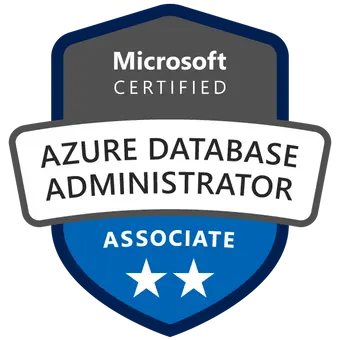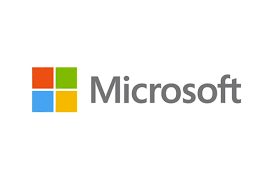Få nye IT-ferdigheter, bli sertifisert og løft IT-karrieren til nye høyder uten å sprenge banken!
Unlimited Taining – IT kurs og sertifiseringer gjort enkelt og utrolig billig. Få tilgang til 60+ Top LIVE-kurs for mindre enn prisen for ett kurs.











course: Microsoft Certified Azure Database Administrator (DP-300)
Varighed: 4 days
Format: Virtual or Classroom
![]() Forberedelse til Eksamen :
Administering Relational Databases on Microsoft Azure (DP-300)
Forberedelse til Eksamen :
Administering Relational Databases on Microsoft Azure (DP-300)
![]() Forberedelse til Sertifisering :
Microsoft Certified: Azure Database Administrator Associate
Forberedelse til Sertifisering :
Microsoft Certified: Azure Database Administrator Associate
Å oppnå Microsoft Certified Azure Database Administrator sertifiseringen er ikke en lett oppgave, men med ditt Readynez kurs og Learning Program har vi gjort alt vi kan for å støtte deg fra start til slutt, og sikre at du har de optimale forutsetningene for å lykkes. Dette inkluderer de beste ressursene som er tilgjengelige for å hjelpe deg med å forberede deg, inkludert relevante online kurs, tilgang til praktiske labs, Practice Test for eksamensforberedelser, study guides, eksamensstøtte og veiledninger osv., alt gjort lett tilgjengelig for deg i vår Learning Platform. Velger du vårt Virtual Training-alternativ, bidrar du også til en mer bærekraftig verden med en reduksjon i CO2-utslipp på 96% sammenlignet med alternativet i klasserommet.
![[Dictionary item: Green-check]](/images/green-check.png) Inkluderer omfattende læremateriell for best mulig eksamensforberedelse
Inkluderer omfattende læremateriell for best mulig eksamensforberedelse![[Dictionary item: Green-check]](/images/green-check.png) Inkluderer tilgang til omfattende Labs i 180 dager, noe som gir deg praktisk hands-on erfaring
Inkluderer tilgang til omfattende Labs i 180 dager, noe som gir deg praktisk hands-on erfaring![[Dictionary item: Green-check]](/images/green-check.png) Inkludert i vårt Unlimited Training tilbud, som gir deg tilgang til alle våre Microsoft kurs
Inkludert i vårt Unlimited Training tilbud, som gir deg tilgang til alle våre Microsoft kurs![[Dictionary item: Green-check]](/images/green-check.png) Full støtte tilgjengelig som hjelper deg med å registrere deg, forberede deg til og ta eksamen
Full støtte tilgjengelig som hjelper deg med å registrere deg, forberede deg til og ta eksamenMicrosoft Azure Database Administrator-sertifiseringen er en verdifull sertifisering for profesjonelle som ønsker å demonstrere sin ekspertise i å administrere Azure SQL-databaser. Sertifiseringseksamenen, DP-300, dekker et bredt spekter av emner som er avgjørende for Azure SQL-databaseadministrasjon, for eksempel sikkerhet, høy tilgjengelighet, katastrofegjenoppretting, ytelsesoptimalisering og databasemigrering og oppgraderingsoperasjoner.

Readynez er den beste treningsleverandøren jeg har brukt på mange år. Kundeservicen deres er førsteklasses, prisene er veldig konkurransedyktige og instruktørene er utmerket.

Lett å delta over Teams og en utmerket instruktør ga meg stor verdi for tiden jeg investerte.
Ditt personlige Learning Program vil gi deg ferdighetene du trenger slik at du kan gjøre mer av det du elsker. Learning Programmet's tre trinn er utformet slik at du lærer nye ferdigheter som vil åpne opp for nye muligheter for deg.

Readynez365 plattformen gir en forbedret digital vei for alle læringselementene dine, fra forberedelse til eksamen, noe som gjør den til den mest direkte veien til nye tekniske ferdigheter. Velg hva du vil (og trenger) for å gjøre deg klar. Det hele er forberedt for deg i Readynez365 i god tid før kursene dine.
Treningsmetodikken er designet for det virtuelle klasserommet, med fokus på å inspirere og engasjere deg med en blanding av praktisk opplæring, presentasjoner, tekniske laboratorier og tester. Du vil også være glad for å vite at virtuell trening er elsket av ledere – det er den mest kostnadseffektive måten å trene på.
Det er et maksimalt antall deltakere i teamet for å sikre deg enkel tilgang til personlig coaching. Du vil møte akkrediterte ekspertinstruktører som er erfarne IT-fagfolk og konsulenter som er sertifisert til høyeste nivå og som bringer den virkelige verden inn i undervisningen.
Vi dekker alle detaljene slik at du kan bruke det i ditt daglige arbeid, og du vil til og med lære detaljene du trenger å vite til eksamen. Det er ditt valg om du vil gå opp til eksamen eller ikke, men med våre detaljerte eksamensveiledninger og hotline gjør vi det enkelt å få tilgang til eksamensbeviset ditt og planlegge og fullføre eksamen online
Din tilgang til trening er ubegrenset, og du kan trene så mye du vil frem til du består eksamen.
Tren med god samvittighet med kurs som gir 96 % lavere CO2-avtrykk sammenlignet med trening i klasserommet. Organisasjonen vår opererer med minimal miljøpåvirkning og vi har redusert våre CO2-utslipp med 96 % siden 2019. Vi overholder ISO 14001 gjennom hele forsyningskjeden vår som din garanti for våre bærekraftige kurs.
- Azure Data Platform-roller
- Azure-databaseplattformer og -alternativer
- SQL Server-kompatibilitetsnivåer
- Azure forhåndsvisningsfunksjoner
- Distribuere SQL Server ved hjelp av IaaS
- Distribuere SQL Server ved hjelp av PaaS
- Implementering av åpen kildekode-databaseløsninger på Azure
- Konfigurer databaseautentisering
- Konfigurer databaseautorisasjon
- Implementere sikkerhet for data i hvile
- Implementere sikkerhet for data i transitt
- Implementere samsvarskontroller for sensitive data
- Grunnlinjer og ytelsesovervåking
- Viktige årsaker til ytelsesproblemer
- Konfigurere ressurser for optimal ytelse
- Konfigurasjon av brukerdatabase
- Ytelsesrelaterte vedlikeholdsoppgaver
- Forstå SQL Server Query Plans
- Utforsk ytelsesbasert databasedesign
- Evaluere ytelsesforbedringer
- Sette opp automatisk distribusjon
- Definere planlagte oppgaver
- Konfigurering av utvidede hendelser
- Administrere Azure PaaS-ressurser ved hjelp av automatiserte metoder
- Strategier for høy tilgjengelighet og katastrofegjenoppretting
- IaaS-plattform og databaseverktøy for HADR
- PaaS-plattform og databaseverktøy for HADR
- Sikkerhetskopiering og gjenoppretting av database
Møt noen av instruktørene du kan møte på kurset ditt. De er eksperter, lidenskapelig opptatt av yrket sitt og dedikert til å gi kunnskapen sin tilbake til industrien, yrket og de som ønsker å lære, utforske og fremme karrieren.

Ed har vært en Microsoft MVP i mange år og har skrevet flere offisielle Microsoft kurs for Azure, Windows Server og Windows.

Tiago Costa er Microsoft MVP, Cloud Architect og rådgiver og internasjonal foredragsholder på Microsoft Cloud.
Hos Readynez stiller vi med mange ressurser og har erfarne eksperter på området. Derfor lykkes vi også med mange fornøyde kunder. Du kan derfor trygt ta kurset ditt hos oss. For å ta DP-300 kurset kreves det imidlertid noen forkunnskaper.
Du har det perfekte utgangspunktet for å ta dette kurset med disse forutsetningene:
Med 15 års erfaring og mer enn 50 000 fornøyde kunder fra hele verden, stoler organisasjoner som ALSO, ATEA, Microsoft, Serco og mange flere på at Readynez trener og sertifiserer sine ansatte.
![[Dictionary item: Green-check]](/images/green-check.png) Topprangerte kurs, med flest deltakere som scoret kurset 10/10
Topprangerte kurs, med flest deltakere som scoret kurset 10/10![[Dictionary item: Green-check]](/images/green-check.png) 50 000 deltakere trent og sertifisert
50 000 deltakere trent og sertifisert![[Dictionary item: Green-check]](/images/green-check.png) Globalt anerkjente ekspertinstruktører, hvorav mange er MVP
Globalt anerkjente ekspertinstruktører, hvorav mange er MVP![[Dictionary item: Green-check]](/images/green-check.png) Betrodd leverandør av store opplæringsprosjekter for mange store organisasjoner
Betrodd leverandør av store opplæringsprosjekter for mange store organisasjonerDette er bare noen av de mange organisasjonene som stoler på Readynez




Å oppnå Microsoft Azure Data Engineer sertifiseringen er ikke en lett oppgave, men med ditt Readynez kurs og Learning Program har vi gjort alt vi kan for å støtte deg fra start til slutt, og sikre at du har de optimale forutsetningene for å lykkes. Dette inkluderer de beste ressursene som er tilgjengelige for å hjelpe deg med å forberede deg, inkludert relevante online kurs, tilgang til praktiske labs, Practice Test for eksamensforberedelser, study guides, eksamensstøtte og veiledninger osv., alt gjort lett tilgjengelig for deg i vår Learning Platform. Velger du vårt Virtual Training-alternativ, bidrar du også til en mer bærekraftig verden med en reduksjon i CO2-utslipp på 96% sammenlignet med alternativet i klasserommet.
SE KURSÅ oppnå Microsoft Azure Cosmos DB Developer Specialist sertifiseringen er ikke en lett oppgave, men med ditt Readynez kurs og Learning Program har vi gjort alt vi kan for å støtte deg fra start til slutt, og sikre at du har de optimale forutsetningene for å lykkes. Dette inkluderer de beste ressursene som er tilgjengelige for å hjelpe deg med å forberede deg, inkludert relevante online kurs, tilgang til praktiske labs, Practice Test for eksamensforberedelser, study guides, eksamensstøtte og veiledninger osv., alt gjort lett tilgjengelig for deg i vår Learning Platform. Velger du vårt Virtual Training-alternativ, bidrar du også til en mer bærekraftig verden med en reduksjon i CO2-utslipp på 96% sammenlignet med alternativet i klasserommet.
SE KURSWorking with functional consultants, solution and technical architects, the Azure Database Administrator will translate data related requirements into essential system functionality for financial and operational apps.
This Microsoft DP-300 exam covers a wide range of topics, including data migration from legacy systems and external systems, application lifecycle management, functional design planning for solution implementations utilizing Lifecycle Services, and administration of Azure Database environments (LCS).
The Administering Relational Databases on Microsoft Azure exam is suitable for candidates working as database administrators and data management specialists responsible for managing on-premises and cloud relational databases built with Microsoft SQL Server and Microsoft Azure Data Services. It requires experience with conventional application code patterns, extensible functionality, and third-party integrations. It also requires expertise in software development, data integrity, and data security compliance to succeed in this position. The underlying frameworks, data structures, and objects linked to Azure Database's administrative solutions must also be well-understood and familiar. Candidates should also understand all concepts covered in Exam DP-900: Microsoft Azure Data Fundamentals.
You must meet the following requirement to achieve the Microsoft Certified Azure Database certification:
You will learn the following:
Azure role-based certifications have a one-year expiration date. Your certification will always be listed on your official Microsoft transcript, but in a different area from your active certificates. To renew your Microsoft certification you must pass an online renewal assessment on Microsoft Learn.
Typical job roles for people holding this certification are:
Both of them managing on-premise and cloud databases utilizing Microsoft SQL Server and Microsoft Azure Data Services.
The syllabus for the DP-300 exam includes the following domains:
The Virtual Classroom is an online room, where you will join your instructor and fellow classmates in real time. Everything happens live and you can interact freely, discuss, ask questions, and watch your instructor present on a whiteboard, discuss the courseware and slides, work with labs, and review.
Yes, you can sit exams from all the major Vendors like Microsoft, Cisco etc from the comfort of your home or office.
With Readynez you do any course from the comfort of your home or office. Readynez provides support and best practices for your at-home classroom and you can enjoy learning with minimal impact on your day-to-day life. Plus you'll save the cost and the environmental burden of travelling.
Well, learning is limitless, when you are motivated, but you need the right path to achieve what you want. Readynez consultants have many years of experience customizing learner paths and we can design one for you too. We are always available with help and guidance, and you can reach us on the chat or write us at info@readynez.com.
Datoer:
Tider:

